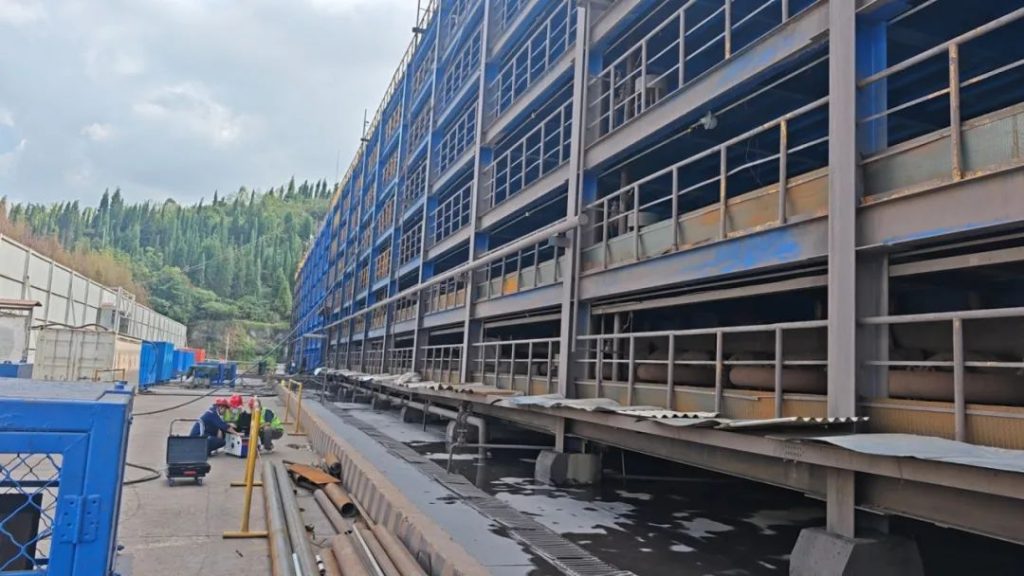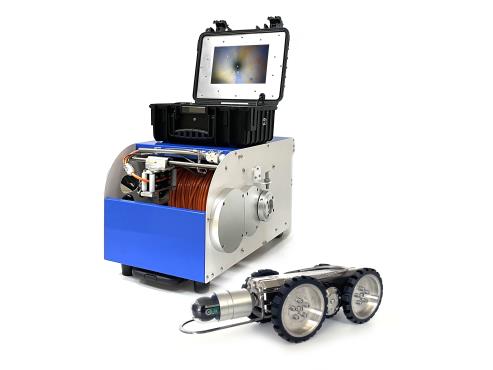
As an important inorganic material, alumina is widely used in many industries. including ceramics, glass, refractory materials, electronics, metallurgy, and chemical industry.
In the production process, the pipeline system plays a vital role, including the transportation of raw materials, dissolution, and heat exchange. However, these pipelines operating in a high temperature, high pressure, and highly corrosive environment for a long time, and are prone to problems such as wall thickness reduction, blockage, scarring, and leakage, which seriously affect production safety and efficiency. Therefore, it is particularly important to regularly inspect and maintain alumina pipelines.
Pipe inspection cameras system have a valuable role in maintaining and optimizing alumina pipes within industries like aluminum production. These pipelines transport alumina (aluminum oxide), an abrasive and dry powder, between processing stages. Using cctv pipeline inspection crawler cameras helps in ensuring the smooth, efficient, and safe operation of these pipelines.
Below are key applications of pipeline inspection crawler cameras in alumina pipelines:
1. Early Detection of Blockages:
- Blockages Monitoring: Alumina particles can accumulate in certain sections of the pipeline, leading to partial or full blockages. Pipe Inspection Camera System allow inspector to inspect this blockages early, preventing disruption in the alumina transport process.
- Flow Efficiency Maintenance: Regular inspections ensure the smooth flow of material, minimizing downtime or reduced output due to clogs.
2. Erosion and Wear Assessment:
- Internal Surface Inspection: The abrasive nature of alumina can wear down the internal surfaces of the pipeline over time. Industrial Pipe Inspection Cameras help monitor this erosion and assess when it need maintenance or replacement, preventing sudden failures.
- Pipe Thickness Monitoring: Pipe Inspection cameras can measure the thickness of the pipe walls, Ensure that erosion does not weaken to a critical point.
3. Crack and Leak Detection:
- Structural Integrity Checks: Over time, high pressures, vibration, or thermal changes can cause cracking or leaking in alumina pipelines. CCTV Pipe Inspection Cameras are used to identify even small cracks or potential weak spots.
- Leak Detection: Leaks in alumina pipelines can lead to material loss and contamination of surrounding equipment. Jiutai Pipe Inspection Cameras System help spot these leakages, especially in areas where manual inspection is difficult.
4. Corrosion Inspection:
- Material Integrity Inspection: Although alumina itself is non-corrosive, pipelines may corrode due to environmental factors, such as moisture, chemicals, or interactions with other materials in the plant. CCTV Pipe Cameras can inspect corrosion damage on the inner and outer surfaces of pipes.
- Preventive Maintenance: By regularly checking for corrosion, pipe inspector can replace or repair corroded sections before they result in serious damage.
5. Post-Cleaning Verification:
- Cleaning Effectiveness: After cleaning, remove alumina buildup, Use pipe cameras are inspect pipelines cleanliness , ensuring that no significant material remains that could obstruct the flow.
- Reducing Cleaning Costs: Pipe Cameras help reduce the need for repeated or excessive cleaning operations by confirming the condition of the pipeline in real-time.
6. Post-Repair Inspection:
- Ensuring Repair Quality: After maintenance or repairs, cctv inspection cameras can ensure the quality and success of the work. They check for residual defects, cracks, or leaks. and confirm the pipeline is operational again.
- Preventing Further Issues: Post-repair inspections can prevent minor defects from turning into major problems down the line, ensuring that repaired sections are free of any issues.
7. Hard-to-Reach Areas Inspection:
- Remote Inspection Capability: Alumina pipelines often run through confined spaces or complex areas within industrial plants. Inspection cameras, especially when mounted on flexible cables or robotic crawlers, can access areas that are difficult for human inspectors to reach, ensuring a thorough examination of the entire pipeline.
- Safety Benefits: The use of cctv pipe inspection cameras reduces the need for human entry into confined spaces or hazardous environments, improving worker safety.
8. Minimizing Unplanned Downtime:
- Proactive Maintenance: Regular inspections with pipeline cameras help identify issues early, allowing plant operators to address problems before they cause major disruptions or shutdowns.
- Increasing Operational Efficiency: By catching issues early and optimizing maintenance schedules, inspection cameras contribute to more consistent pipeline operation. and reduce production delays.
9. Correlating Visual Data with Performance Issues:
- Real-Time Monitoring: Pipe Cameras provide real-time video and picture feedback, that can using alongside other monitoring systems, such as pressure or flow sensors, to better understand performance issues in the pipeline.
- Immediate Troubleshooting: In the event of performance issues or suspected blockages, cameras can be quickly deployed to pinpoint the problem location and provide immediate insights for troubleshooting.
10. Inspection Report System:
- Detailed Inspection Reports: Inspection cameras capture images and videos that can be used for documentation purposes, providing a visual record of the pipeline’s condition over time.
- Infrastructure Mapping: For plants expanding or making modifications to their infrastructure, cctv pipeline inspection crawler cameras help map out the existing pipeline network, ensuring accurate planning and design.
Technologies Used:
- CCTV Crawler Cameras: Typically used for larger diameter pipes, CCTV inspection cameras are mounted on robotic crawlers that can move through the pipeline while capturing real-time footage.
- Pipe Push Cameras: These are flexible, cable-mounted cameras that can be pushed through smaller or more confined pipes, providing inspection capabilities in tight spaces.
- HD 360 Degree Borescope Cameras: These cameras capture detailed, high-quality images and videos, often providing a full view of the pipe’s internal surface.
- Integrated Sensors: Some inspection cameras come with additional sensors (for example, ultrasonic or laser-based) to measure pipeline wall thickness, detect leaks, and monitor other structural parameters.
- Other NDT Inspection Tools

Conclusion:
Pipeline inspection cameras in alumina pipe play a critical role in maintaining the efficiency, so that safety of industrial operations. On the other hand they enable early detection of issues like blockages, erosion, leaks, and corrosion, helping to reduce downtime, extend the life of the pipeline, and optimize the overall production process in aluminum plants or other industries handling alumina.






